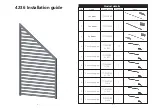
Installation
Ensure that the drain is suitable if the water is coloured with dye following flow
visualisation demonstrations.
Installation Guide
The Hydraulics Bench is supplied fully assembled and only requires filling with water
and connection to an electrical supply for it to be operational.
When the bench has been encased in a wooden crate, for protection during shipping,
remove the wooden crate taking care not to damage the bench inside.
Carefully remove the protective cardboard cover from the bench by raising it
vertically upwards.
Remove any additional packaging materials from the measuring cylinder, stilling
baffle and flexible feed pipe. Ensure that the stilling baffle is located inside the
volumetric tank adjacent to the rectangular cut-out at the end of the moulded channel
in the bench top. Place the measuring cylinder and flexible feed pipe in a secure
location.
Position the Hydraulics Bench in the desired location on a firm level surface following
the recommendations in the section ‘Installation Requirements’.
The F1-10 Hydraulics Bench is designed for static location on a firm level floor. For
ease of mobility, the bench is mounted on four castors, two of which have brakes.
A temporary supply of clean, cold water is required for the initial filling of the sump
tank. A drain is required when emptying the sump tank after use. The water may be
coloured with dye provided that this is non-staining and safe for student use.
For ease of mobility, the bench is mounted on four castors, two of which have
brakes. Release the brakes and position the bench adjacent to the water supply.
Check that all packaging has been removed from the bench, close the drain valve in
the front wall of the sump tank and apply the brakes before filling the sump tank with
water.
Before filling with water for the first time it is suggested that the bench is cleaned
using a cloth soaked in warm soapy water to remove any grease or dirt that has
accumulated during shipping.
Place a filling hose into the overflow slot in the side wall of the volumetric tank so that
water will flow directly into the sump tank. Lift the dump valve (sealing ball and
weight) out of the aperture in the base of the volumetric tank so that the level inside
the sump tank can be observed.
Add a few drops of wetting agent to the sump tank, via the aperture in the base of the
volumetric tank, to minimise the effects of surface tension.
Note:
If too much wetting agent is added foaming will occur and it will be necessary
to replace the water.
Turn on the water supply and allow the sump tank to fill until the water level is just
below the outlet in the bottom of the volumetric tank.
When the sump tank is full, turn off the water supply and remove the filling hose.
Replace the dump valve in the base of the volumetric tank and locate the actuator in
9












































